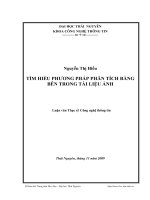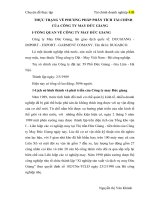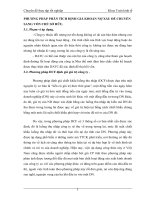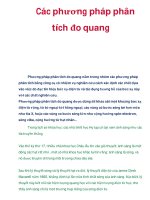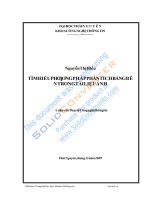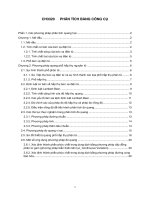Tiêu chuẩn ASTM E 1999 (2011) về phương pháp phân tích bằng quang phổ phát xạ để kiểm soát những nguyên tố hóa học trong hợp kim gang
Bạn đang xem bản rút gọn của tài liệu. Xem và tải ngay bản đầy đủ của tài liệu tại đây (114.61 KB, 7 trang )
Designation: E1999 − 11
Standard Test Method for
Analysis of Cast Iron by Spark Atomic Emission
Spectrometry1
This standard is issued under the fixed designation E1999; the number immediately following the designation indicates the year of
original adoption or, in the case of revision, the year of last revision. A number in parentheses indicates the year of last reapproval. A
superscript epsilon (´) indicates an editorial change since the last revision or reapproval.
1. Scope
priate safety and health practices and determine the applicability of regulatory limitations prior to use.
1.1 This test method covers the analysis of cast iron by
spark atomic emission spectrometry for the following elements
in the concentration ranges shown (Note 1):
2. Referenced Documents
1.2 This test method covers analysis of specimens having a
diameter adequate to overlap the bore of the spark stand
opening (to effect an argon seal). The specimen thickness
should be sufficient to prevent overheating during excitation. A
heat sink backing may be used. The maximum thickness is
limited only by the height that the stand will permit.
1.3 This standard does not purport to address all of the
safety concerns, if any, associated with its use. It is the
responsibility of the user of this standard to establish appro-
2.1 ASTM Standards:2
E135 Terminology Relating to Analytical Chemistry for
Metals, Ores, and Related Materials
E158 Practice for Fundamental Calculations to Convert
Intensities into Concentrations in Optical Emission Spectrochemical Analysis (Withdrawn 2004)3
E172 Practice for Describing and Specifying the Excitation
Source in Emission Spectrochemical Analysis (Withdrawn
2001)3
E305 Practice for Establishing and Controlling Atomic
Emission Spectrochemical Analytical Curves
E351 Test Methods for Chemical Analysis of Cast Iron—All
Types
E406 Practice for Using Controlled Atmospheres in Spectrochemical Analysis
E826 Practice for Testing Homogeneity of a Metal Lot or
Batch in Solid Form by Spark Atomic Emission Spectrometry
E1019 Test Methods for Determination of Carbon, Sulfur,
Nitrogen, and Oxygen in Steel, Iron, Nickel, and Cobalt
Alloys by Various Combustion and Fusion Techniques
E1329 Practice for Verification and Use of Control Charts in
Spectrochemical Analysis
E1601 Practice for Conducting an Interlaboratory Study to
Evaluate the Performance of an Analytical Method
E1763 Guide for Interpretation and Use of Results from
Interlaboratory Testing of Chemical Analysis Methods
1
This test method is under the jurisdiction of ASTM Committee E01 on
Analytical Chemistry for Metals, Ores, and Related Materials and is the direct
responsibility of Subcommittee E01.01 on Iron, Steel, and Ferroalloys.
Current edition approved May 15, 2011. Published July 2011. Originally
approved in 1999. Last previous edition approved in 2004 as E1999 – 99 (2004).
DOI: 10.1520/E1999-11
2
For referenced ASTM standards, visit the ASTM website, www.astm.org, or
contact ASTM Customer Service at For Annual Book of ASTM
Standards volume information, refer to the standard’s Document Summary page on
the ASTM website.
3
The last approved version of this historical standard is referenced on
www.astm.org.
Elements
Concentration Ranges, %
Applicable Range, %
Quantitative Range, %A
Carbon
Chromium
Copper
Manganese
Molybdenum
Nickel
Phosphorus
Silicon
Sulfur
Tin
Titanium
Vanadium
1.9 to 3.8
0 to 2.0
0 to 0.75
0 to 1.8
0 to 1.2
0 to 2.0
0 to 0.4
0 to 2.5
0 to 0.08
0 to 0.14
0 to 0.12
0 to 0.22
1.90
0.025
0.015
0.03
0.01
0.02
0.005
0.15
0.01
0.004
0.003
0.008
to
to
to
to
to
to
to
to
to
to
to
to
3.8
2.0
0.75
1.8
1.2
2.0
0.4
2.5
0.08
0.14
0.12
0.22
A
Quantitative range in accordance with Practice E1601.
NOTE 1—The concentration ranges of the elements listed have been
established through cooperative testing of reference materials. These
concentration ranges can be extended by the use of suitable reference
materials.
Copyright © ASTM International, 100 Barr Harbor Drive, PO Box C700, West Conshohocken, PA 19428-2959. United States
1
E1999 − 11
TABLE 1 Analytical and Internal Standard Lines, Possible
Interferences
E1806 Practice for Sampling Steel and Iron for Determination of Chemical Composition
2.2 Other Documents:
MNL 7A Manual on Presentation of Data and Control Chart
Analysis4
Element
Wavelength, nm
Reported Possible
Interfering
Elements
Carbon
193.09
Al, Mo, Cu, S
3. Terminology
Chromium
267.72
265.86
Mo, S, Mn
3.1 Definitions— For definitions of terms used in this test
method, refer to Terminology E135.
Copper
211.21
221.81
327.40
510.55
Ni
Manganese
293.31
Cr, Mo, W
Molybdenum
202.03
281.61
Ni
Mn
Nickel
243.79
231.60
341.48
352.45
Mn
Mn
Phosphorus
178.29
Cr, Mn, Mo, Cu
Silicon
212.41
251.61
288.16
Mo, Cu, Ni
Mo, Cr
Sulfur
180.73
Mn, Cu, Cr
Tin
189.99
Mn, Mo, Fe
Titanium
334.90
337.28
334.19
Cr
Fe
Vanadium
310.23
311.07
Ni
IronA
273.07
271.44
281.33
360.89
4. Summary of Test Method
4.1 A capacitor discharge is produced between the flat,
ground surface of the disk specimen and a conically shaped
electrode. The discharge is terminated at a predetermined
intensity of a selected iron line, or at a predetermined time, and
the relative radiant energies of the analytical lines are recorded
and converted to concentration.
4.2 Carbon, phosphorus, sulfur and tin emit in the vacuum
ultraviolet region. The absorption of the radiation by air in this
region is overcome by flushing the spark chamber with argon
or argon-hydrogen gas mixture and either evacuating the
spectrometer or filling the spectrometer with an inert gas such
as nitrogen or argon. A capacitor discharge is produced
between the flat, ground surface of the disk specimen and a
conically shaped electrode. The discharge is terminated at a
predetermined intensity of a selected iron line, or at a predetermined time, and the relative radiant energies of the analytical lines are recorded and converted to concentration.
NOTE 2—It is not within the scope of this test method to prescribe
specific details of every instrument that could be used for the analysis of
cast iron by spark atomic emission spectrometry. The parameters listed in
this test method represent the parameters of the specific instruments used
during the interlaboratory study to produce the precision and bias listed in
this test method. Other spark atomic emission spectrometers with different
parameters may be used provided that they produce equivalent or better
precision and bias data
Mo, P
V
Mo
A
Internal standard.
5. Significance and Use
5.1 The chemical composition of cast iron alloys shall be
determined accurately in order to insure the desired metallurgical properties. This procedure is suitable for manufacturing
control and inspection testing.
produce precision and accuracy results equal to or better than
the results in the interlaboratory study for this test method are
acceptable.
7. Apparatus
6. Interferences
7.1 When required, use sample preparation equipment as
follows:
7.1.1 Sample Mold, to produce graphite-free white chilled
iron samples that are homogeneous, free of voids or porosity in
the region to be excited, and representative of the material to be
analyzed. A chill-cast disk approximately 40 mm (1 1⁄2 in.) in
diameter and 3-mm to 12-mm (1⁄8-in. to 1⁄2-in.) thick is
satisfactory. A sample mold made from copper with a low
oxygen content has proven to be optimum for this purpose.
Refer to Practice E1806 for iron sampling procedures.
7.1.2 Surface Grinder or Sander with Abrasive Belts or
Disks, capable of providing a flat, clean, uniform surface on the
reference materials and specimens.
6.1 Interferences may vary with spectrometer design and
excitation characteristics. Direct spectral interferences may be
present on one or more of the wavelengths listed in a method.
Frequently, these interferences shall be determined and proper
corrections made by the use of various reference materials.
Refer to Table 1 for possible interferences. The composition of
the sample being analyzed should match closely the composition of one or more of the reference materials used to prepare
and control the calibration curve. Alternatively, mathematical
corrections may be used to solve for interelement effects (refer
to Practice E158). Various mathematical correction procedures
are commonly utilized. Any of these correction procedures that
4
7.2 Excitation Source, capable of providing sufficient energy to sample the specimen and excite the analytes of interest.
ASTM Manual Series, ASTM, 6th Edition, 1990.
2
E1999 − 11
See Practice E172. Any other excitation source whose performance has been proven to be equivalent may be used.
9. Calibrants
9.1 Calibrants can come in three forms: certified reference
materials, reference materials, and analyzed production
samples. In selecting calibrants, use caution with compositions
that are unusual. One element may adversely influence the
radiant energy of another element or its uniformity of distribution within the material. Tests should be made to determine
if interrelations exist between elements in the calibrants. To
compensate for inter-element effects, it is suggested that the
calibrants approximate the composition of the material to be
tested. The metallurgical history of the calibrants should be
similar to that of the specimens being analyzed in accordance
with the recommendations of Practice E305.
7.3 Excitation Chamber, automatically flushed with argon or
other inert gas. Clean the excitation chamber when the counter
electrode is replaced.
NOTE 3—Clean the lens or protective window as recommended by the
instrument manufacturer.
7.4 Spectrometer, having sufficient resolving power and
linear dispersion to separate clearly the analytical lines from
other lines in the spectrum in the spectral region 170.0 nm to
520.0 nm. The spectrometers used to test this method had a
dispersion of 0.3 nm/mm to 0.6 nm/mm and a focal length of
0.5 m to 0.75 m. Spectral lines are listed in Table 1. The
primary slit width is 15 µm to 50 µm. Secondary slit width is
15 µm to 200 µm. The spectrometer shall be provided with one
or more of the following:
7.4.1 An air/gas inlet and a vacuum outlet. The spectrometer
shall be operated at a vacuum of 25 µm of mercury or below.
7.4.2 A gas inlet and a gas outlet.
7.4.3 Sealed with nitrogen or other inert gas.
9.2 Certified Reference Materials (CRMs), used as calibrants for chill-cast iron alloys are available commercially.
9.3 Reference Materials (RM’s), used as calibrants for
chill-cast iron alloys are available commercially.
NOTE 6—The distinction is made between CRMs and production
materials because there are commercially available RMs produced by
reputable producers that do not claim to be CRMs but in all other respects
fit the definition of CRMs.
7.5 Measuring System, consisting of photomultipliers having individual voltage adjustment, capacitors on which the
output of each photomultiplier is stored and an electronic
system to measure voltages on the capacitors either directly or
indirectly, and the necessary switching arrangements to provide the desired sequence of operation.
9.4 Analyzed Production Samples shall be chemically analyzed test specimens taken from production heats produced
according to Practice E1806. They shall cover the concentration ranges of the elements to be determined and shall include
all of the specific types of alloys being analyzed. These
calibrants shall be homogeneous and free of voids and porosity.
Refer to Test Methods E351 and E1019 or other nationally
accepted test methods for chemical analysis of iron base alloys.
Refer to Practice E826 for information on homogeneity testing
of reference materials.
7.6 Readout Console or Computer, capable of indicating the
ratio of the analytical lines to the internal standard with
sufficient precision to produce the accuracy of analysis desired.
7.7 Gas System, consisting of an argon or argon-hydrogen
supply with pressure and flow regulation. Automatic sequencing shall be provided to actuate the flow at a given rate for a
specific time interval. The flow rate may be manually or
automatically controlled. The gas system shall be in accordance with Practice E406.
10. Preparation of Calibrants and Specimens
10.1 Specimens, cast graphite-free specimens from molten
metal into a suitable mold and cool. Refer to Practice E1806
for information on the preparation of specimens for analysis.
7.8 Vacuum Pump, if required, capable of maintaining a
vacuum of 25 µm Hg or less.
10.2 Preparation, prepare the surface to be analyzed on a
suitable belt or disk grinder. Prepare the surface of the
specimens and calibrants in a similar manner. All specimens
shall be free of moisture, oil, and residue for proper excitation.
NOTE 4—A pump with a displacement of at least 0.23 m3/min (8
ft3/min) is usually adequate.
10.3 Specimen porosity is undesirable because it leads to
the “diffuse-type” rather than the desired “concentrated-type”
discharge. The specimen surface should be kept clean because
the specimen is the electron emitter, and electron emission is
inhibited by oily, dirty surfaces.
8. Reagents and Materials
8.1 Inert Gas (Argon, Nitrogen), or Hydrogen, as required,
shall be of sufficient purity to permit proper excitation of the
analytical lines of interest in the excitation chamber or light
transmittance in the spectrometer chamber. Use in accordance
with Practice E406.
10.4 Calibrants and specimens shall be refinished dry on a
belt or disc sander before being re-excited on the same area.
8.2 Counter Electrodes—A silver or thoriated tungsten rod
of 2-mm to 6-mm diameter ground to a 30° to 90° conical tip.
Other material may be used provided it can be shown experimentally that equivalent precision and accuracy are obtained.
11. Specimen Excitation Parameters
11.1 Operate the spectrometer according to the manufacturer’s instructions.
NOTE 5—A black deposit may build up on the tip of the electrode, thus
reducing the overall intensity of the spectral radiation. The number of
acceptable excitations on an electrode varies from one instrument to
another and should be determined in each laboratory. Cleaning electrodes
after each burn significantly reduces this buildup and gives more consistent results.
NOTE 7—When parameters are established, maintain them carefully.
The variation of the power supply voltage shall not exceed 65 % and
preferably should be held within 62 %.
11.1.1 An example of excitation parameters for a highenergy unidirectional spark source is listed below:
3
E1999 − 11
Capacitance, µF
Inductance, µH
Resistance, V
Potential, V
Number of discharges/s
Preburn
10
20
0
550
120
with different random sequences at least two times. Using the
average intensity of the data for each point, determine analytical curves as described in Practices E158 and E305. (Note 10)
Exposure
10
20
4.4
350
60
13.2 Standardization— Following the manufacturer’s
recommendations, standardize on an initial setup or anytime
that it is known or suspected that readings have shifted. Make
the necessary corrections either by adjusting the controls on the
readout or by applying arithmetic corrections. Standardization
shall be done anytime verifications indicate that readings have
gone out of statistics control.
11.2 Spark Conditions (Note 8)—An example of spark
parameters is listed below:
Flush period, s
Preburn period, s
Exposure period, s
2 to 10
5 to 20
5 to 20
Gas Flow
Flush
Preburn
Exposure
ft3/h
5 to 45
5 to 45
5 to 30
L/min
2.5 to 25
2.5 to 25
2.5 to 15
13.3 Verification shall be done at least at the beginning of
instrument operation. A number of warm-up burns may be
necessary. Analyze verifiers with duplicate burns to confirm
that the average of the two burns falls within the control limits
established in 17.1.
13.3.1 Check the verification after standardizing. Each laboratory should determine the frequency of verification necessary
based on statistical analysis. Refer to 17.1. Typically, every 4
or 8 hours is practical and adequate. If results are not within the
control limits established in 17.1, perform a standardization
and then repeat verification. Repeat standardization as necessary so verifications are within control limits or investigate
further for instrument problems.
NOTE 8—Select preburn and exposure periods after a study of volatization rates during specimen excitation. Once established, maintain the
parameters consistently. The instrument manufacturer can normally provide this information.
11.3 Electrode System— For conventional capacitor discharge excitation systems, the specimen, electrically negative,
serves as one electrode. The opposite electrode or counter
electrode is a thoriated tungsten or silver rod. Use a 3-mm to
6-mm (0.125-in. to 0.25-in.) analytical gap. Once a gap size is
selected, maintain it consistently. Condition a fresh counter
electrode with 2 excitations to 6 excitations. A high-purity
argon atmosphere is required for the analytical gap. Molecular
gas impurities, nitrogen, oxygen, hydrocarbons, or water vapor,
either in the gas system or from improperly prepared specimens should be minimized.
NOTE 10—Modern instruments are very stable, and the software may
not permit more than one set of intensity data to be averaged for the
calibration curves since it is unnecessary.
14. Procedure for Excitation and Radiation Measurement
12. Preparation of Apparatus
14.1 Check the standardization by verification as listed in
13.3.
12.1 Prepare the spectrometer in accordance with the manufacturer’s instructions. Program the spectrometer to accommodate the internal standard lines and one of the analytical lines
for each element listed in Table 1.
14.2 Produce and record the radiation intensities for each
element using the conditions given in Section 11.
14.3 Replicate Excitation—Make a minimum of two burns
on each specimen. Average the replicate readings for each
element if their difference does not exceed twice the established standard deviation for the element. If their difference
exceeds this value, analyze the specimen two more times and
average all four readings. In all cases, discard readings caused
by observable defects in the specimen and replace it with
another reading. When placing the freshly surfaced specimen
on the excitation stand, position it to effect a gas tight seal and
adequate gas flushing. Position the specimen so that there will
be a uniform pattern of burns around its surface. For example,
a disk-shaped specimen should have a ring of burn marks
around its outer edge and approximately 6 mm (1⁄4 in.) from the
edge. Avoid burning the center of cast specimens where there
is more likely to be quench cracks and segregation. Make
certain there is a good electrical connection between the
specimen and the specimen ground. Cool the specimen after
two burns to prevent overheating, if required. Successive burns
shall be sufficiently separated so that the burn patterns do not
overlap.
12.2 Test the positioning of the spectrometer entrance slit to
ensure that peak radiation is entering the spectrometer chamber. This shall be done initially and as often as necessary to
maintain proper entrance slit alignment. Follow the manufacturer’s recommended procedures. The laboratory shall determine the frequency of positioning the alignment based on
instrument performance.
12.3 Exit slit positioning and alignment is normally performed by the manufacturer at spectrometer assembly. Under
normal circumstances, further exit slit alignment is not necessary (Note 9).
NOTE 9—The manner and frequency of positioning or checking the
position of the exit slits will depend on such factors as the type of
spectrometer and the frequency of use. Each laboratory should establish a
suitable check procedure.
13. Calibration, Standardization, and Verification
13.1 Calibration— Using the parameters in Section 11,
excite each calibrant and potential standardant two to four
times in random sequence, bracketing these with excitations of
any materials intended for use as verifiers (a verifier may be
used as a calibrant even though it is used principally as a
verifier). There should be at least seven calibrants for each
element, spanning the required concentration range. Repeat
14.4 Examine the specimen and instrument measurements
after each burn to evaluate the quality of excitation. Cracks,
voids, pit, moisture, or inclusions will invalidate the sampling
and accuracy of a determination.
4
E1999 − 11
TABLE 2
15. Calculation of Results
15.1 Average the readings obtained for each element.
16. Precision and Bias
16.1 Precision:
16.1.1 Seven laboratories cooperated in performing this test
method and obtained the statistical information summarized in
Tables 2-4.5 The interlaboratory data were evaluated in accordance with Practices E1601 and E1763. An approximate value
for the expected reproducibility index, R, can be calculated for
carbon with the following equation:
R 5 C c 3 0.059
(1)
where: Cc is the expected carbon content in the range 1.9 %
to 3.8 %.
TABLE 2 Precision Data
Test
Material
Number
of
Laboratories
Found,
%
Minimum Reproduc- Reproducibility SD
ibility
SD (SM,
Practice (SR, Prac- Index (R,
E1601) tice E1601) Practice
E1601)
Rrel %
D
C
A
E
B
F
7
7
7
7
7
7
1.970
2.426
2.986
3.063
3.495
3.717
Carbon
0.0125
0.0204
0.0151
0.0192
0.0221
0.0208
0.0364
0.0577
0.0685
0.0478
0.0818
0.1641
0.1019
0.1616
0.1919
0.1337
0.2289
0.4596
5.17
6.66
6.42
4.36
6.55
12.36
F
A
C
B
E
D
7
7
7
7
7
7
0.1044
0.3089
0.5350
0.7153
1.091
2.048
Chromium
0.0028
0.0019
0.0031
0.0028
0.0050
0.0068
0.0045
0.0107
0.0182
0.0133
0.0152
0.0500
0.0126
0.0301
0.0510
0.0373
0.0425
0.1401
12.08
9.74
9.52
5.22
3.89
6.84
F
C
E
B
A
DA
7
7
7
7
7
7
0.0145
0.1386
0.4935
0.5404
0.7611
0.9820
Copper
0.00082
0.00164
0.0064
0.0045
0.0069
0.0123
0.00249
0.01001
0.0204
0.0194
0.0131
0.0657
0.00698
0.02802
0.0570
0.0543
0.0367
0.1841
47.98
20.22
11.55
10.04
4.82
18.74
F
D
A
E
B
C
7
7
7
7
7
7
0.2019
0.6932
0.8060
0.990
1.201
1.813
Manganese
0.0018
0.0055
0.0039
0.0048
0.0092
0.0094
0.0061
0.0232
0.0128
0.0132
0.0161
0.0376
0.0172
0.0650
0.0357
0.0369
0.0451
0.1052
8.50
9.38
4.43
3.72
3.76
5.80
A
F
E
C
D
B
7
7
7
7
7
7
0.0269
0.1031
0.3018
0.4459
0.5015
1.151
Molybdenum
0.00061
0.0017
0.0027
0.0051
0.0027
0.0048
0.00172
0.0042
0.0050
0.0146
0.0139
0.0128
0.00481
0.0118
0.0139
0.0408
0.0389
0.0358
17.87
11.47
4.60
9.14
7.75
3.11
F
A
B
E
7
7
7
7
0.0654
0.0876
0.5722
0.7498
Nickel
0.00108
0.00132
0.0042
0.0077
0.00299
0.00396
0.0266
0.0303
0.00837
0.01108
0.0745
0.0849
12.79
12.65
13.01
11.33
Continued
Test
Material
Number
of
Laboratories
Found,
%
Minimum Reproduc- Reproducibility SD
ibility
SD (SM,
Practice (SR, Prac- Index (R,
E1601) tice E1601) Practice
E1601)
D
C
7
7
1.259
1.981
0.0129
0.0181
F
A
C
E
D
B
6
7
7
7
7
6
0.0037
0.0230
0.0300
0.0502
0.0784
0.4141
F
E
A
C
B
D
7
7
7
7
7
7
0.5272
1.082
1.917
2.058
2.224
2.519
F
E
A
C
D
B
6
7
7
7
7
7
A
D
B
C
E
Rrel %
0.0543
0.0759
0.1520
0.2125
12.08
10.73
0.00129
0.00124
0.00166
0.00354
0.00419
0.02530
0.00360
0.00347
0.00465
0.00990
0.01173
0.07084
96.95
15.04
15.50
19.71
14.96
17.11
Silicon
0.0051
0.0082
0.0120
0.0226
0.0123
0.0131
0.0354
0.0300
0.0432
0.1071
0.0562
0.0894
0.0991
0.0841
0.1209
0.2999
0.1574
0.2504
18.80
7.77
6.30
14.57
7.08
9.94
0.0023
0.0058
0.0464
0.0554
0.0576
0.0776
Sulfur
0.00028
0.00062
0.00158
0.00418
0.00219
0.00449
0.00114
0.00166
0.00595
0.00665
0.00501
0.01176
0.00318
0.00464
0.01667
0.01862
0.01402
0.03294
141.31
79.93
35.91
33.60
24.35
42.43
7
7
7
7
7
0.0119
0.0318
0.0541
0.0561
0.1367
Tin
0.00025
0.00042
0.00044
0.000537
0.00109
0.00076
0.00196
0.00247
0.00290
0.00335
0.00214
0.00363
0.00692
0.00812
0.00937
17.98
11.42
12.79
14.47
6.85
A
B
D
C
E
6
6
6
6
6
0.0105
0.0339
0.0805
0.0865
0.1114
Titanium
0.00028
0.00033
0.00046
0.00133
0.00586
0.00108
0.00138
0.00993
0.00520
0.00720
0.00304
0.00387
0.02779
0.01456
0.02015
28.95
11.42
34.52
16.83
18.09
A
D
E
C
B
7
7
7
7
7
0.0071
0.0501
0.0851
0.1199
0.2166
Vanadium
0.00015
0.00068
0.00053
0.00163
0.00099
0.00150
0.00298
0.00255
0.00483
0.00672
0.00419
0.00836
0.00715
0.01352
0.01883
59.01
16.69
8.40
11.28
8.69
Phosphorus
0.00019
0.00038
0.00051
0.00074
0.00148
0.00361
A
Sample D is not included in determining the scope of testing in 1.1.
TABLE 3 Constants for Reproducibility Index Equation
A
Chromium
Copper
Manganese
Molybdenum
Nickel
Phosphorus
Silicon
Sulfur
Tin
Titanium
Vanadium
KR
Krel
B
0.0126
0.007
0.016
0.005
0.0064
0.0024
0.066
0.0032
0.002
0.00138
0.0042
0.062
0.067
0.050
0.031
0.11
0.17
0.075
0.35
0.067
0.17
0.087
2.0
0.75
1.80
1.20
2.0
0.40
2.5
0.08
0.14
0.12
0.22
16.1.2 An estimate of the reproducibility index for the other
analytes, RA, can be calculated with the following equation:
R A 5 = @ K R21 ~ C A 3 K
rel
! 2 # over the analyte range of 0 to B
where:
CA = expected analyte content in %,
5
Supporting data have been filed at ASTM International Headquarters and may
be obtained by requesting Research Report RR:E01-1027.
5
(2)
E1999 − 11
TABLE 4
B = upper limit of the analyte range in % (from Table 3),
and
KR and Krel are constants for each analyte from Table 3.
16.1.3 Laboratories participating in the interlaboratory
study used the same set of calibration specimens. Users are
warned that comparisons of results between laboratories using
different sets of calibration materials may experience greater
differences in results than is implied by the calculated values
for R from the equation or Table 2.
Test
Material
16.2 Bias—The accuracy of this test method at certain
concentration levels may be judged by comparing the accepted
reference values with the arithmetic average obtained by
interlaboratory testing (see Table 4). Users are warned that the
accuracy of results from applying the method depend upon the
accuracy of the calibration materials used and the care with
which the calibration is performed.
Test
Material
Material Identification,
Uncertainty or (SD)
1.94
2.36
2.97
3.01
3.50
3.82
1.970
2.426
2.986
3.063
3.495
3.717
0.030
0.066
0.016
0.053
0.005
−0.103
0.11
0.320
0.52
0.725
1.11
2.03
Chromium
0.1044
−0.0056
0.3089
−0.0111
0.5350
0.0150
0.7153
−0.0096
1.091
−0.019
2.048
0.018
BS 2C
BS 1C
BS 290A
BS 3C
CKD U
BS 4C
0.576
0.75
1.26
1.99
0.5722
0.7498
1.259
1.981
−0.0043
−0.0002
−0.001
−0.009
CKD U
BS 3C
BS 2C
BS 1C
(0.0044)
0.02
0.03
0.02
F
A
C
E
D
B
0.003
0.024
0.029
0.051
0.078
0.414
Phosphorus
0.0037
0.0007
0.0230
−0.0010
0.0300
0.0010
0.0502
−0.0008
0.0784
0.0004
0.4141
0.0001
BS 4C
BS 290A
BS 1C
BS 3C
BS 2C
CKD U
0.001
0.002
0.002
0.003
0.002
(0.007)
F
E
A
C
B
D
0.52
1.08
1.89
2.02
2.25
2.51
0.527
1.082
1.917
2.058
2.224
2.519
BS 4C
BS 3C
BS 290A
BS 1C
CKD U
BS 2C
0.02
0.02
0.02
0.02
(0.014)
0.05
F
E
A
C
D
B
0.001
0.003
0.051
0.060
0.062
0.077
0.0023
0.0058
0.0464
0.0554
0.0576
0.0776
0.0013
0.0028
−0.0046
−0.0046
−0.0044
0.0007
BS 4C
BS 3C
BS 290A
BS 1C
BS 2C
CKD U
0.0005
0.001
0.002
0.003
0.004
(0.0008)
A
D
B
C
E
0.011
0.031
0.057
0.054
0.136
0.0119
0.0318
0.0541
0.0561
0.1367
0.0009
0.0008
−0.0029
0.0021
0.0007
BS 290A
BS 2C
CKD U
BS 1C
BS 3C
0.001
0.002
(0.0010)
0.002
0.005
A
B
D
C
E
0.012
0.035
0.080
0.083
0.111
0.0105
0.0339
0.0805
0.0865
0.1114
Titanium
−0.0014
−0.0011
0.0005
0.0035
0.0004
BS 290A
CKD U
BS 2C
BS 1C
BS 3C
(0.0009)
(0.0011)
0.005
0.004
0.004
A
D
E
C
B
0.007
0.049
0.086
0.12
0.221
0.0071
0.0500
0.0851
0.1199
0.2166
Vanadium
0.0001
0.0010
−0.0009
0.0001
−0.0044
BS 290A
BS 2C
BS 3C
BS 1C
CKD U
0.001
0.004
0.008
0.01
(0.0057)
0.007
0.002
0.027
0.038
−0.025
0.009
Sulfur
Carbon
D
C
A
E
B
F
B
E
D
C
Material Identification,
Uncertainty or (SD)
Silicon
TABLE 4 Bias Information
Assumed
Average
True Value, Spectrometer Difference, %
%
Value, %
Continued
Assumed
Average
True Value, Spectrometer Difference, %
%
Value, %
0.02
0.03
0.05
0.03
(0.007)
0.03
Tin
F
A
C
B
E
D
BS 4C
BS 290A
BS 1C
CKD U
BS 3C
BS 2C
0.005
0.005
0.03
(0.008)
0.02
0.02
Copper
F
C
E
B
A
DA
0.014
0.133
0.48
0.551
0.75
0.90
0.0145
0.1386
0.4935
0.5404
0.7611
0.982
F
D
A
E
B
C
0.21
0.67
0.80
0.98
1.21
1.79
A
F
E
C
D
B
F
A
0.0005
0.0056
0.0135
−0.0106
0.0111
0.082
BS 4C
BS 1C
BS 3C
CKD U
BS 290A
BS 2C
0.002
0.005
0.01
(0.0095)
0.01
0.02
Manganese
0.2019
−0.008
0.6932
0.023
0.806
0.006
0.990
0.010
1.201
−0.009
1.813
0.023
BS 4C
BS 2C
BS 290A
BS 3C
CKD U
BS 1C
0.01
0.01
0.01
0.01
(0.012)
0.02
0.024
0.105
0.30
0.43
0.50
1.16
Molybdenum
0.0269
0.0029
0.1031
−0.0019
0.3018
0.0018
0.4459
0.0159
0.5015
0.0015
1.151
−0.009
BS 290A
BS 4C
BS 3C
BS 1C
BS 2C
CKD U
0.002
0.005
0.01
0.015
0.02
(0.0125)
0.068
0.088
0.0654
0.0876
Nickel
−0.0026
−0.0004
BS 4C
BS 290A
0.002
0.004
A
Sample D is not included in determining the scope of testing in 1.1.
17. Maintaining Analytical Credibility
17.1 Users are encouraged to include this test method in an
accountability and quality control program. Refer to Practice
E1329 for procedures to control analysis, including the use of
control charts. Support for the use of control charts with
respect to a given standard appear in MNL 7A.
18. Keywords
18.1 cast iron; spark atomic emission; spectrometric analysis
6
E1999 − 11
ASTM International takes no position respecting the validity of any patent rights asserted in connection with any item mentioned
in this standard. Users of this standard are expressly advised that determination of the validity of any such patent rights, and the risk
of infringement of such rights, are entirely their own responsibility.
This standard is subject to revision at any time by the responsible technical committee and must be reviewed every five years and
if not revised, either reapproved or withdrawn. Your comments are invited either for revision of this standard or for additional standards
and should be addressed to ASTM International Headquarters. Your comments will receive careful consideration at a meeting of the
responsible technical committee, which you may attend. If you feel that your comments have not received a fair hearing you should
make your views known to the ASTM Committee on Standards, at the address shown below.
This standard is copyrighted by ASTM International, 100 Barr Harbor Drive, PO Box C700, West Conshohocken, PA 19428-2959,
United States. Individual reprints (single or multiple copies) of this standard may be obtained by contacting ASTM at the above
address or at 610-832-9585 (phone), 610-832-9555 (fax), or (e-mail); or through the ASTM website
(www.astm.org). Permission rights to photocopy the standard may also be secured from the ASTM website (www.astm.org/
COPYRIGHT/).
7
